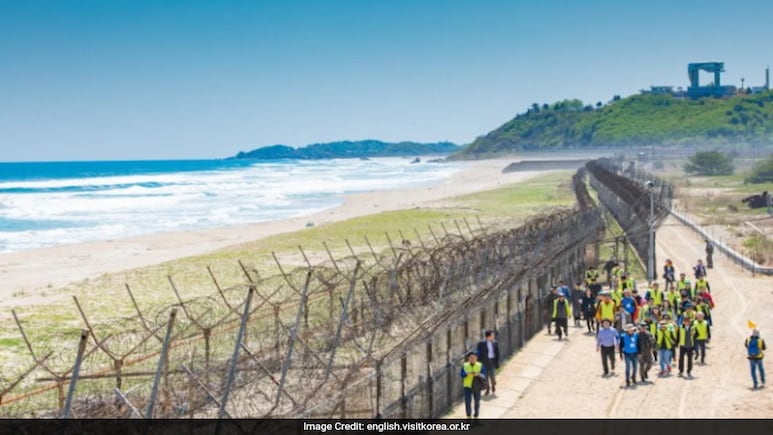
- Displaced North Koreans have lived near the Demilitarised Zone on Ganghwado Island for over 70 years
- The Demilitarised Zone is a 248km long, 4km wide buffer zone established after the Korean War armistice
- The Demilitarised Zone Peace Trail promotes peace and commemorates countries aiding South Korea in the war
"I can see the hill that I used to play on and the house in which I lived," says Chae Ja Eok, a displaced North Korean whose hometown is only six kilometres away from the Gyondong village near the Demilitarised Zone on the Ganghwado Island in northwest South Korea.
Chae, who has lived for the last 70 years in Gyondong village, says he could never go back or know about what happened to his parents.
"My parents probably would have passed away when they were in their 50s or 60s. I feel a sense of guilt and sadness that I don't even know where they are buried," he says.
The Demilitarised Zone on the Ganghwado Island in northwest South Korea offers a rare glimpse into the lives of displaced North Koreans who have been living there for over 70 years.
The Ganghwado Island, about 60 kilometres from Seoul, is separated from North Korea by the connecting waters of the Yesong and Han Rivers, making it one of South Korea's closest frontiers to its neighbouring communist state, just 1.8 kilometres away.
The Demilitarised Zone (DMZ), the 248-kilometre-long, four-kilometre-wide buffer zone serving as the de facto border with North Korea, was established after an armistice agreement at the end of the Korean War in 1953. Theoretically, it means both Koreas are still at war.
The DMZ Peace Trail project-the main attraction on this island-aims to promote the development and prosperity of the border areas and solidify peace in the DMZ in accordance with the 2018 agreement between the leaders of the two Koreas, according to South Korea's Ministry of Unification.
The walkway at the DMZ Peace Trail is flanked by almost 8-10 feet tall fences with spiralled barbed wires on top.
The docent, tour guide, explained the history of the Korean War that broke out on June 25, 1950, and lasted till June 27, 1953, as she showcased plaques installed in the park of 16 countries that helped South Korea in the Korean War.
Korea's national flower, Mugunghwa, is planted at the memorial to commemorate the dead in that war. Mugunghwa, meaning 'eternal blossom that never fades,' has been considered an important symbol of Korean culture for centuries.
The next stop on the trail is Mangbaedan Altar, which allows families who have been separated from their relatives in North Korea to hold ancestral rites and make bows toward their hometown, the docent informed.
The Daeryong Market on Gyodongdo Island, northwest of Ganghwado, is a front-line island facing Yeonbaek-gun County of North Korea's Hwanghae-do Province.
This traditional market started after Korean War refugees opened stalls to make a living.
For many displaced people who have lived in the Gyodong village of Gyodongdo Island, time has stood still for over 70 years since they left their hometowns in North Korea.
The nostalgia is heightened by the fact that the village, with its traditional tin-roof houses, looks like a typical South Korean village from the 1970s.
There are scores of North Koreans who could never return to their hometowns, despite the proximity, after the Korean War ended in 1953, and no one knows the history of the island and also of the displaced people better than Son Yun Gyeong.
Energetic and lively, the youthful 62-year-old is a representative of Cheongchun Bravo (Cheongchun translates to youth), a cultural space for displaced seniors from North Korea, in the Daeryong Market.
The Centre sells a variety of delicacies and sweets such as puppy rice cake and dumplings (mando) made in North Korean style.
"The North Korean-style puppy rice cakes and North Korean dumplings made by Cheongchun Bravo are food items that recreate the memories of the elderly displaced people from Hwanghae-do (North Korea) in Gyodong," she added.
The Trail also has a peace observatory and a reunification aspiration hall that further offers glimpses of the North Korean way of life.
The Trail was initially opened in 2019 to commemorate the first anniversary of the inter-Korean summit of April 27, 2018. Foreign visitors were allowed only in 2023, and access is still restricted for them.
An officer from the Arms Control and Proliferation Division of the Korean National Defence Ministry said, "Access to foreigners at the DMZ is still restricted because of security reasons." The international tourists are made to deposit their mobile phones at the entry point of the DMZ. Photography is restricted in many areas.
The Ganghwa Peace Observatory also has a small museum explaining the North Korean way of life with models of rooms of houses that mimic North Korea. The observatory also offers a chance to look through binoculars into the North Korean territory.
Also, on the Trail, there is a "Reunification Aspiration Hall", which contains a digital tree wishing comfort for the separated families and peaceful unification.
(Except for the headline, this story has not been edited by NDTV staff and is published from a syndicated feed.)
Track Latest News Live on NDTV.com and get news updates from India and around the world

